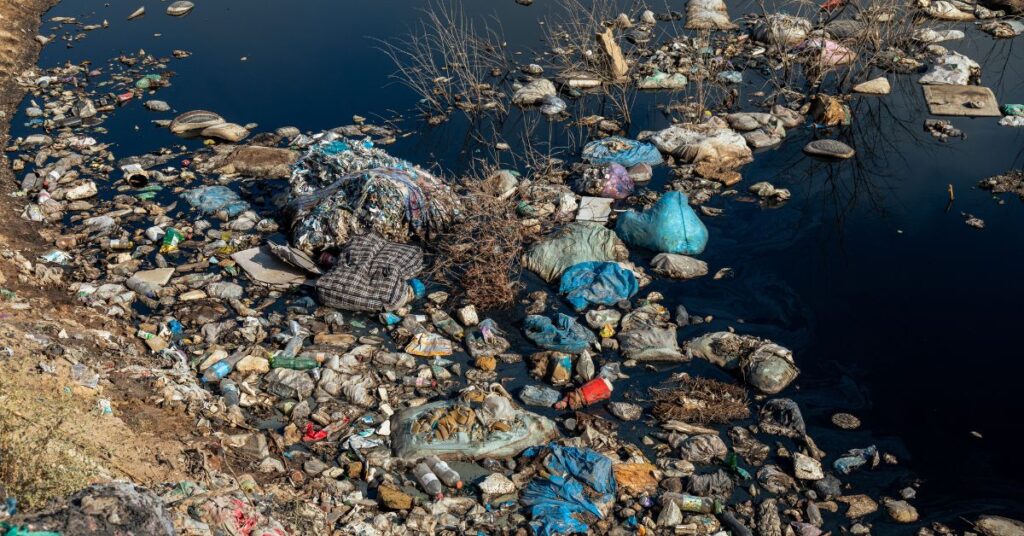Understanding marine plastic pollution & its impact on ecosystem

Marine plastic pollution has become a leading environmental concern, causing severe harm to marine life and ecosystems.
Plastic pollution has become a significant worldwide environmental issue, with a particular focus on its impact on ocean ecosystems. Plastic is a highly prevalent and persistent pollutant that poses a substantial risk to marine life and the overall well-being of marine ecosystems.
This investigation aims to explore the detrimental impacts of plastic pollution and emphasize the pressing necessity for worldwide intervention to mitigate this ecological crisis.
It also investigates the ecological ramifications of marine plastic pollution and its severe effects on aquatic organisms.
Where Does the Pollution Caused by Plastic Come From?
Plastic Pollution from Human Trash and Waste
Littering is a significant contributor to the presence of plastic in marine environments. Litter left on beaches, refuse illegally dumped in rivers, and waste carried from streets contribute to a significant issue.
Much of the waste is derived from the use of disposable plastics. Straws, bottles, bags, crisp packets, stirrers, coffee cups, and yogurt pots are everyday waste items.
Much of our waste is derived from single-use plastics discarded after a single use. Occasionally, we dispose of it in the bin, while other times, we neglect to do so, resulting in its eventual entry into our oceans. Single-use items are challenging to recycle.
Consider a coffee cup as an illustrative example. Approximately 2.5 billion takeaway coffee cups are discarded annually. Many individuals believe that these cup-like containers are capable of being recycled.
However, the plastic lining that provides heat resistance and waterproofing is frequently attached to the paper exterior in a manner that prevents recycling. Consider bringing a reusable cup when planning to get takeaway.
Alternatively, one may choose to consume the beverage within the establishment’s premises by opting for a ceramic coffee cup, provided they have a spare duration of approximately five minutes.
Plastic Contamination in Our Rivers
Approximately 80% of plastic waste is transported from rivers to the ocean. A recent Earthwatch Europe and Plastic Oceans UK report revealed that plastic drink bottles accounted for 14% of identifiable plastic waste in European freshwaters. Food wrappers and takeaway cups were highly prevalent, accounting for 12% and 6% of the total waste, respectively. All of these items are disposable and cannot be recycled.
Plastic Pollution from Sewage Systems
Plastic waste is introduced into marine environments through sewage systems. Plastic-stemmed cotton buds and disposable wet wipes are frequently flushed, causing significant damage to sewer systems, marine pollution, and harm to aquatic organisms.
Microplastics are significant contributors to water pollution. Micro-plastics, which are less than five millimeters in length, pose challenges in terms of filtration. Microplastics are introduced into water bodies through various sources, such as facial scrubs and synthetic clothing, which release fibers during washing. A single laundry cycle has the potential to remove approximately 700,000 micro-plastic fibers.
Plastic Pollution from the Fishing Industry
Ghost gear, which refers to discarded fishing equipment, significantly contributes to plastic pollution in marine environments. Abandoned nets significantly threaten marine life, resulting in approximately 3,200 reported incidents of wildlife harm in England and Wales last year.
Effects of Plastic Pollution on Oceans and Marine Life
Plastic Accumulation and Fragmentation
Plastic waste, such as bottles, bags, and microplastics, is progressively amassing in marine environments. Plastic remains in the marine environment for extended periods due to its non-biodegradable properties.
Consequently, it undergoes fragmentation, resulting in the formation of micro-plastics, which are smaller particles measuring less than 5mm in size. Marine organisms across various trophic levels, ranging from zooplankton to large marine mammals, ingest microplastics.
Threats to Marine Species
Plastic pollution significantly impacts marine species, such as seabirds, turtles, fish, and marine mammals. Birds and turtles often confuse plastic debris with food, resulting in digestive system blockages, malnutrition, and potential mortality.
Marine mammals are at risk of entanglement in abandoned fishing nets and other plastic debris, resulting in various harm, such as injuries, drowning, or suffocation. Moreover, the consumption of microplastics can disturb marine organisms’ feeding and reproductive behaviors, thereby impacting population dynamics.
Marine Ecosystem Disruption
Marine plastic pollution jeopardizes the integrity and functionality of the entire marine ecosystems. Coral reefs, commonly known as the “rainforests of the sea,” are susceptible to plastic debris, which has the potential to suffocate and cause the death of coral polyps.
Plastic pollution negatively affects the photosynthetic activity of phytoplankton, which serves as the basis for marine food chains. Plastic on the ocean floor modifies the structure of the habitat, which in turn impacts the diversity and distribution of benthic organisms.
Chemical Contamination
Plastic materials contain diverse additives, some of which possess toxic properties. Plastic debris in the marine environment can release harmful chemicals, including bisphenol A (BPA), polychlorinated biphenyls (PCBs), and phthalates.
Marine organisms can absorb these chemicals, which bio-accumulate as they progress through the food chain. Consuming contaminated organisms can have adverse health effects on humans, such as endocrine disruption and developmental abnormalities.
Impact on Coastal Communities
Plastic pollution harms marine life and coastal communities, which depend heavily on the oceans’ well-being for sustenance. The fishing and tourism sectors are negatively impacted by the degradation of marine ecosystems and the depletion of fish populations.
In addition, the disposal and control of plastic waste place significant financial burdens on coastal communities and local governments.
Potential Solutions and Future Perspectives
Addressing marine plastic pollution necessitates a comprehensive approach that encompasses the participation of individuals, governments, and industries. Several possible solutions exist.
a. Reducing the Use of Plastic
Encouraging the adoption of reusable products and exploring alternatives to single-use plastics can effectively mitigate plastic waste generation.
b. Waste Management and Recycling
To prevent plastic waste from accessing the oceans, it is crucial to establish efficient waste management systems, enhance recycling infrastructure, and enforce extended producer responsibility.
c. Education and Awareness are Crucial Factors
Educational campaigns can promote responsible consumption habits and induce behavioral change by increasing awareness of the consequences of marine plastic pollution.
d. Innovation and Research
It is essential to focus on developing biodegradable plastics, implementing advanced waste-to-energy technologies, and conducting long-term studies on the ecological impact of marine plastic pollution to mitigate its effects effectively.
EDITOR’S VIEW ON THE Marine Plastic Pollution
Marine plastic pollution has significant ecological implications that require urgent attention. The negative impacts on marine life, marine ecosystems, and coastal communities underscore the urgent need to address this crisis.
By implementing sustainable practices, investment in research and innovation, and collaborative efforts, it is possible to ensure the preservation of oceanic health and the protection of its invaluable biodiversity.


The writer believes awareness is the solution for change. Her comprehension in the field of ecology and environmental studies is impactful. With her knowledge, she had written much content for academic websites and well-known publishing platforms. Here, at BleedGreen, she urges us to share her wisdom of words to bring cognizant in the society for our green resources.




